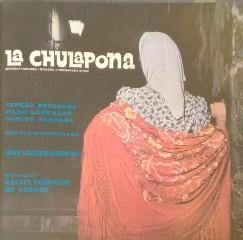Moreno Torroba - La Chulapona (Burgos) [1988]
Moreno Torroba - La Chulapona (Burgos) [1988]

1 Introducción Y Mazurca - "Las Chicas De Madrid" 2 Chotis Y Pasacalle Madrileño - "Como Soy Chulapona" / Terceto "He Venido Pa Decirle" 3 Dúo - "Ese Pañuelito Blanco" 4 Introducción Y Guajira / Pasacalle Madrileño - "Dejaría De Ser Madrileño" 5 Chotis-Habanera - "Dígale Usted A Esa Chulapa" 6 Romanza - "Tienes Razón, Amigo" / Bulerías, Tanguillo, Petenera Y Zapateado / Terceto "No Desafíes, Mujer" 7 Chotis - "¡Ay, Madrileña Chulapa!" 8 Dúo - "Confieso Que Le Quise Por Envidia" Manuela - Teresa Berganza Rosario - Pilar Lorengar José María - Carlos Fagoaga El Chalina - Joaquín Portillo Juan De Dios - Julio Uribe Venustiana - Sélica Pérez Carpio Cantaora - Mari Carmen Ramírez Señor Antonio - Antonio Ayestarán Emilia - Charo Ormazábal Coro de Cámara del Orfeón Donostiarra Orquesta Sinfónica R. Frühbeck De Burgos - Conductor
For many, the lyric comedy La chulapona (Madrid, Teatro Calderón, 31st March 1934) is the quintessential Madrid zarzuela. It is certainly a fabulous compendium of the dances, sounds and popular scenes of that lost Golden Age of the 1890's which it evokes so strongly. Yet beyond the barrel organs, café-bar castanets and guitars, what distinguishes La chulapona from several other nostalgic 'retro' zarzuelas of the pre-Civil War years?
Romero and Shaw packed their highly theatrical libretto with a host of situations familiar from the género chico classics of Chueca, Chapí and Torregrosa (whose La fiesta de San Anton is notably similar in general outline) without inducing any sense of deja vu. At the centre of their colourful web of characters is the inevitable love triangle; yet all three luckless lovers are sympathetically drawn, not least La chulapona Manuela herself. Many find her self-sacrifice tragic; but the librettists ensure a conclusion very far from downbeat, by providing a hint that she may be better off with the steady Señor Antonio after all.
As with Luisa Fernanda, Torroba provided a score of unusual length. Indeed some punctilious commentators have preferred to define the pair as operones ('half-operas') rather than zarzuelas. The music has had its detractors, mainly on the grounds that La chulapona doesn't have the melodic inspiration of Luisa Fernanda. Whilst there may be a grain of truth in this, such was inevitable in an ensemble work with room for only one solo Romanza - José María's "Tienes razón, amigo", which lacks nothing in quality. The final Dúo for the two women is equally distinguished, as is the orchestral Nocturno; but elsewhere the score is more notable for smiling energy and operetta-lightness of touch than for emotional depth.
As those fortunate enough to see the Teatro de la Zarzuela's 1988 production or its subsequent revivals can readily testify, any such doubts are blown away in the theatre, where La chulapona's dazzling mixture of popular song, catchy dance and orchestral wizardry has enthralled audiences at home and abroad. Indeed, its ecstatic reception at the 1995 Edinburgh Festival exploded the received idea that Madrid zarzuela was somehow too provincial to travel, in one, joyous blast. --- zarzuela.net
download (mp3 @320 kbs):
yandex 4shared mega mediafire uloz.to cloudmailru uplea








